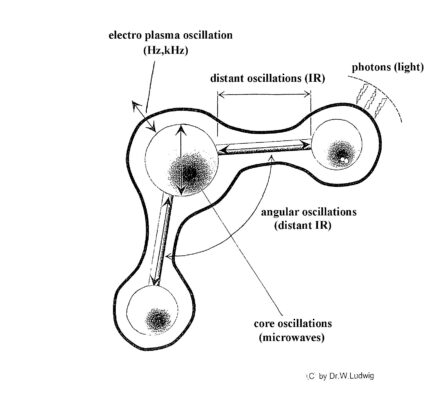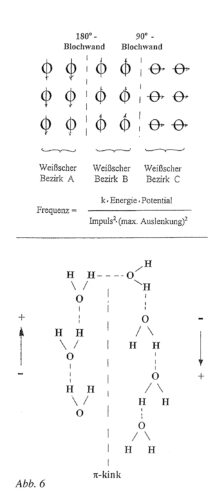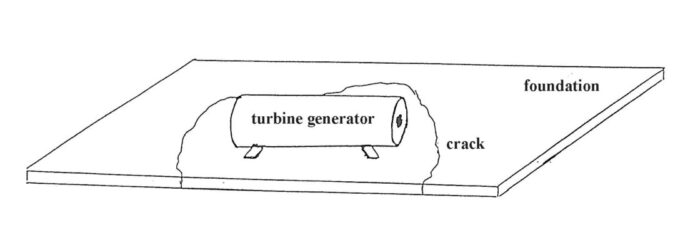The theory of bioinformative medicine
The practical application of the latest discoveries
Introduction:
In the alternative medicine, it has been shown that it is advantageous to transmit allergens or body substances (blood, spit, saliva) electromagnetically onto an isotonic salt solution and use the resulting nosode for the oral after-treatment of the patient. This transmission is only comprehensible when a phase relationship between the patient and the nosode exists. The holographic world view can deliver the best explanation for this (see appendix [sic-not available]).
During the process of transferring (oscillatory) information from a substrate onto a watery substance and its storage in the cluster-like structure of the water, the enormous increase in electromagnetic pollution (particularly because of the recent expansion of mobile-telephone transmitter networks) has a significant effect on the signal to noise ratio.
If one is to screen a transfer layout magnetically, then the geomagnetic and Schumann frequencies needed to trigger the transfer are missing but can, however, be artificially reproduced in the screened area.
A simpler solution is to use an input beaker (to accept the substrate to be transmitted) which has been specially constructed to eliminate electromagnetic pollution as much as possible. There now follows a recommendation as to how to minimize electromagnetic pollution and improve the signal to noise ratio to such an extent that the usable signal is measurable above the noise. In a further section, the storage capability of water will be demonstrated by spectroscopic measurements. In the past, one could not imagine that it was possible for “water to have a memory”. However, this opinion was purely theoretical and now outdated.
Compensation for electromagnetic pollution:
In general, substrate information is acquired with the help of a metal honeycomb or beaker which acts like an antenna and receives the characteristic oscillations of the substrate. In the present day, every piece of metal receives a large amount of atmospheric noise which can be much greater than the strength of the required signal. Should a transfer device (impedance-converter, amplifier) be connected, then both signals (usable and interference) are combined in the electronics which at the present time is nonlinear and results in cross-modulation.
This means that the signal with the higher frequency is amplitude-modulated by the lower frequency one just like the AM-radio on medium waves. It is well known that this causes side-bands to be produced. For example, should the substrate signal have a lower frequency than the interfering signal, then the latter signal produces a sideband (side frequency) on each side of its fundamental frequency, in the case of mixed frequencies whole sidebands are produced.
With conventional honeycombs or beakers, these sidebands cannot be found spectroscopically (with a Fourier analyser) because they are much too small in comparison with the interfering signal these days. However, if one can reduce the strength of the interfering signal considerable such that both signals, usable and interfering, are of comparable strength, then sidebands become clearly visible. Fig. 1 shows an example of this phenomena whereby electromagnetic pollution was reduced by a factor of 100 (as explained below).
Figure 1:
In Fig. 1, a special beaker (MEDICUP) connected to an impedance-converter with symmetrical input (WAVE TRANSFER) was used (see Fig. 3) and an ampoule with iodine D6 was placed in the beaker.
The Fourier analyser (signal analyser from the Rockland Company, USA) was adjusted for the frequency band from 5.5 to 5.7 kHz whereby supply mains harmonics of approx. 5 Hz (the fundamental frequency of iodine D6) can be seen. Fig. 2 shows the same spectrum without the iodine D6, i.e. with empty input beaker. Here only the interfering signals without sidebands can be seen, i.e. all that is left over from the interfering signal after extensive compensation.
Figure 2:
Figure 3: Wave Transfer with a Medicup as input and output beaker

It is surprising that even university professors in the faculty of physics are not aware that in watery solutions (and even in pure water) very low frequencies can occur. The 5 Hz signals which are visible in Fig. 1 as side-frequencies clearly belong – as further measurements showed – to the iodine D6 preparation.
When the same measurements were carried out with a conventional beaker, the interfering signal was one hundred times greater and the iodine signal disappeared completely.
The procedure adopted to reduce the strength of the interfering signal is very simple: The beaker is made of two symmetrical halves (one a mirror image of the other) each one of which picks-up practically the same amount of electromagnetic pollution. If the two halves (Fig. 3) are then connected to the symmetrical input of an impedance-converter or amplifier (e.g. WAVE TRANSFER), then the electromagnetic pollution signals being received from both halves of the beaker cancel each other out (common-mode rejection). The substrate in the beaker acts as a dielectric, because the beaker resembles a capacitor.
The clusters in the water oscillate locally in all possible polarisation-planes. They don’t cancel each other out in spite of the symmetrical input. The polarisation planes of electromagnetic pollution are stable over a wide area so that the orientation of the beaker in the room is of some significance; however, as a result of the small gap between the two halves of the beaker, only a small amount of the interfering spectrum remains. The orientation is therefore unimportant.
However, the necessary signals from nature together with the interfering signals are nearly compensated. These natural signals (e.g. geomagnetic frequency spectrum) are therefore generated in the impedance converter in the WAVE TRANSFER by means of a certain technological process which cannot be explained in detail here.
The impedance converter also has the function of not loading the beaker (capacitor), i.e. it must have a very high input impedance (i.e. resistance to alternating current). To transmit the usable signal onto the water, the same bipolar beaker can be connected to the output of the impedance-converter. In order that the beaker does not load the output of the impedance-converter, the latter must have a sufficiently low output impedance. As its name implies, the impedance-converter transforms the high input impedance to a low output impedance.
Normally, impedance-converters contain an inverting stage. The output therefore oscillates out-of-phase with the input from the substrate.
If the impedance-converter doesn’t invert, then the output has the same phase as the input which is normal for healing substances. The opposite (inverted) is true for allergens where the output substance has the opposite effect on the organism as the material in the input. Here it is also a prerequisite that the substance and the body fluid of the patient are triggered externally with regard to the phase position (otherwise the therapeutic effect in harmony with the experience of our currently prevailing world view would not be understandable. A comprehensive explanation of the spatial synchronisation of distant objects and subjects is made available by the holographic world view of the English physicist David Bohm and the American neurophysiologist Karl Pribram in conformity with the experiments of Alain Aspect at the University of Paris. The comprehensive quantized field theory of Burkhard Heim is also able to explain the connection between objects which are apparently separated in space and time. In the appendix [sic-not available], a brief reference will be made to this explanation from an intellectual point of view.
The impedance-converter can also be equipped with an amplifier so that the output voltage is increased and can have a more intensive effect on the water. This leads us to the “memory structure” of water.
The cluster structure of water
Recent experimental work has demonstrated by various methods that water is capable of storing information in a very wide frequency band for a practically unlimited time. Convincing theoretical explanations of this phenomena are available. Fig. 4 shows an example of the inherent frequency of a single water molecule.
Figure 4:
Fundamentally, nothing in the cosmos is stable; on the contrary, everything oscillates with different frequencies. Even at absolute zero (-273,16o C) we have oscillations according to the Heisenberg uncertainty principle. The atomic cores have inherent frequencies in the microwave band; the electron sheath oscillates at low frequency in the Hz and kHz band. This was demonstrated impressively in the television program “Our Cosmos” which the American astrophysicist Carl Sagan produced a few years ago in 12 episodes. In the 9th episode, a uranium atom was shown enlarged 100-million times with an electron microscope and one could clearly see how it pulsated rhythmically at about 10 Hz.
The frequency of angular oscillations (hydrogen-oxygen-hydrogen atoms) occurs in the remote infrared band (between microwaves and infrared light); the frequency of the distant oscillations (hydrogen-oxygen atoms) can be found in the infrared band at 3.2 mm wavelength (about 1012 Hz). These oscillations work as carrier frequency and appear modulated with the other frequencies mentioned here. It therefore also contains sidebands. Finally, by supplying energy to an electron, it can be raised from the normal into an excited state; after a ten millionth of a second it emits a photon (approx. 1015 Hz) and then returns to its original state. This is the highest frequency occurring in water.
Fig. 5 shows an example of a cluster of water molecules. Because the hydrogen in the water carries a positive charge and the oxygen a negative one (as a result of accepting an electron from the hydrogen) and is not a linearly-arranged molecule, the discrete water molecule has a dipole moment. As a result of the formation of hydrogen bonds, water clusters are created. At room temperature, about 400 single water molecules are linked together in clusters.
Figure 5:
This number is derived from spectroscopic measurements and also from the so-called anomaly of the water. The following Table 1 shows the physical data of water and single water molecules. Based on the difference, it can be calculated that in water in liquid form on average 400 single molecules are linked.
Table 1: The anomaly of water based on its physical data
| Physical Data | Is now (cluster) | Should be (single molecules) |
|---|---|---|
| Boiling point | 100° C | -80° C |
| Melting point | 0° C | -100° C |
| Specific gravity | 1 g/ml at 4° C | 0.5 g/ml falling with temp |
| surface tension | 75 dyn/cm | 7 dyn/cm |
The data for single water molecules was extrapolated from the so-called homologous rows in the (Mendelejew) periodic table (see Table 2).
Table 2: The anomaly of water based on its homologous row
Substance (combination with H) ⇒ ⇒ ⇒ ⇒ ⇒ ⇒ ⇒ ⇒ boiling point
| Water | (H2O)n | 373° K |
|---|---|---|
| hydrogen sulphide | H2S | 214° K |
| hydorgen selenide | H2Se | 232° K |
| hydrotelluric acid | H2Te | 272° K |
It is known from chemistry that combinations with elements which are in the same column of the periodic table (and therefore related chemically) have boiling and melting points which increase with the size of the atoms. The lower the element is in the periodic table the bigger the elements / atoms are. In Table 2 one can see that the combination with the smallest atoms (in this homologous row the water) has an enormously high boiling point because water forms clusters of (polymeric) molecules. By extrapolating the boiling-point curve, the number of single molecules in the cluster can be determined (marked with an “n“ in table 2).
In the clusters (Fig. 5) there are significantly more inherent frequencies present than discrete water molecules. The clusters oscillate in the MHz band and the barriers between the clusters (so-called kinks) oscillate at very low frequencies and are similar to the electron sheaths. It is difficult to imagine just how many cluster structures and the associated oscillatory spectra there are.
Figure 6 compares water with iron as they both have the same storage ability.

In water there are electrical dipoles, clusters and kinks, in iron there are magnetic dipoles, domains (Weiss domain) and domain walls which also have inherent frequencies albeit at higher ones because it is a solid body. Just like iron, water can store information although it was previously believed that hydrogen bonds are such weak links that they continuously disintegrate and are recreated, i.e. are unstable. However, we now know that water has a crystalline-liquid component with hydrogen bonds which are joined about twenty times more firmly.
Water as information store
Just what happens when information is transmitted onto water can be explained with a macroscopic model taken from electricity-generation technology. Fig. 7 shows an example of this.
Figure 7:
Fig. 7 is a sketch of a turbine which drives an alternating-current generator that is unbalanced because of a deformed turbine blade. The vibrations from the defective generator are transferred to the concrete foundation which starts to crack. Such cases do arise occasionally and if action is not taken quickly result in a resonance catastrophe. It is well known from experience that the crack in the foundation will choose a path such that the section of the foundation on which the unbalanced system is standing will eventually resonate with the out-of-balance frequency. This means that the vibrations transmitted to the foundation will build up and up until the whole system collapses. Similar resonance catastrophes have also been experienced with bridges when soldiers march over them in step. It is possible to cause bridges to collapse in this way and that is why it is forbidden to march over a bridge in step.
Let us now transfer the analogy to water which is treated with a signal: the signal corresponds to the out-of-balance frequency in Fig. 7, the water to the foundation and the emerging hydrogen bonds to the crack in the foundation. The water clusters will be rearranged until they are exactly in resonance with the signal. Initially this applies to the disordered water with its weakly-linked hydrogen bonds. However to rearrange the strong hydrogen bonds in the crystalline-liquid component, more energy must be supplied. This can, for example, be achieved by vigorous shaking whereby microcavitation occurs and explodes with enormous force. This causes the information to be transferred from the weakly-linked water to the crystalline-liquid component. Exactly the same procedure is used for potentiating homeopathic substances.
It is a fact that preparations which Samuel Hahnemann personally manufactured more than 150 years ago and are now preserved in vaults were recently tested in several laboratories. They have the same inherent frequency and colorplate pictures as homeopathic substances of the same composition and potency manufactured today. The information was retained for more than 150 years!
To improve transmission, amplification over a frequency range as wide as possible with linear phase-frequency characteristic is recommended. Several instruments on the market claim to be able to change the potency of a homeopathic substance with the transmission, usually to increase it whereby the harmonics are amplified. A high potency is accompanied by more harmonics than a lower potency of the same substance however the basic frequency is the same for all potencies.
We know from chemistry that concentrated solutions (corresponding to high potencies) are accompanied by a wide band in the frequency spectrum which by increasing dilution (corresponding to lower potencies) splits up into single spectral lines. If one wants to be on the safe side when transmitting, one should always use the desired potency in the input and not try to increase a lower potency by electronic tricks which never lead to the same result. However one often wants to bypass the tedious potentiating and prefer “electronic potentiating“ whereby spectroscopic comparison measurements show differences between the real potency and the “electronic“ substitute. Such measurements are very time consuming because many average values have to be produced in order to improve the signal to noise ratio. This is why there are very few spectra of homeopathic substances available. Detailed measurements from D5 to D 200 have been carried out on Ipecacuanha.
Should globules be used at the output, the water which is contained in them works as a memory because solid bodies require much more energy for restructuring. Globules should also be shaken vigorously immediately after transmitting the information. In any case it is better to use water and let this be sucked-in by the placebo globule. It should be pointed out that it has been confirmed regularly that very pure water (e.g. Seradest from the Seral company) cannot store information. We recommend the use of aqua marina or a physiological salt solution at the output of the transfer instrument. It would appear that the formation of hydrates is necessary in order to be able to store usable information. There is obviously scope for research work here.
Should information in water need to be erased, a strong magnetic field is very suitable, alternatively heating to boiling point (which is hardly possible with sealed ampules because of the danger of explosion), a power laser in the infrared range, x-rays (the safety checks at airports are too weak and therefore harmless) as well as microwaves.
Unintentional transmission (print-through) between closely packed ampules is very unlikely unless the spacing is less than 1 mm and a (not too strong) magnetic field is present.
 A Special Report Article for Members
A Special Report Article for Members
From THE BRIDGE Newsletter of OIRF
Published December 15, 2007
© Copyright 2003, Advanced Medical Systems, Tauberbischofsheim, Germany



